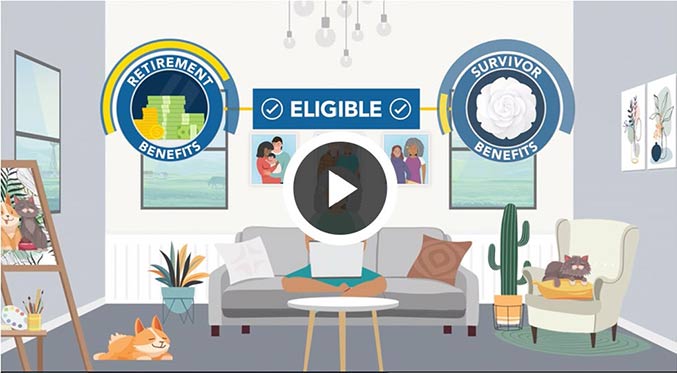When you lose a spouse, you feel lost, confused and your personal circumstances instantly change. The emotional impact is devastating. It may feel impossible to focus on finances, but there are resources that can help. First, you have to draw on your own perseverance and strength. Keep friends and family close. When you're ready to move forward, connect with a trusted financial advisor — someone who can explain death benefits clearly and compassionately. Below you’ll find some helpful information to consider when it comes to benefits you might be owed in the future.

A Guide to Survivor Benefits for Widows
7-minute read

If you are owed benefits, they will likely fall under one of these main categories:
- Social Security benefits for widows
- Survivor’s Pension for widows
- Military Compensation benefits for widows
Protecting your nest egg is vital for you and your family. You’re going to need to preserve as much of your survivor benefits as possible. Let’s look at some of the primary survivor benefits for widows — beginning with an understanding of Social Security and how it may affect your death benefits.
Social Security Survivor Benefits: A Guide for Widows
Widow’s benefits are especially important for families with younger children. However, according to the Social Security Administration, “Social Security survivor benefits begin at age 60. Should you earn more from your retirement than your Social Security death benefit, you’ll automatically be paid the higher amount beginning at age 62.”
Current Social Security Survivor Benefits by Age¹
From ssa.gov
| Year of Birth1 | Full (survivors) Retirement Age2 | At age 62, a $1000 survivor's benefit would be reduced to3: | Months between age 60 and full retirement age | Monthly % Reduction4 |
| 1939 or earlier | 65 | $829 | 60 | .475 |
| 1940 | 65 and 2 months | $825 | 62 | .460 |
| 1941 | 65 and 4 months | $822 | 64 | .445 |
| 1942 | 65 and 6 months | $819 | 66 | .432 |
| 1943 | 65 and 8 months | $816 | 68 | .419 |
| 1944 | 65 and 10 months | $813 | 70 | .407 |
| 1945-1956 | 66 | $810 | 72 | .396 |
| 1957 | 66 and 2 months | $807 | 74 | .385 |
| 1958 | 66 and 4 months | $805 | 76 | .375 |
| 1959 | 66 and 6 months | $803 | 78 | .365 |
| 1960 | 66 and 8 months | $801 | 80 | .356 |
| 1961 | 66 and 10 months | $798 | 82 | .348 |
| 1962 and later | 67 | $796 | 84 | .339 |
- If the survivor was born on January 1 of any year, use the information for the previous year.
- If someone was born on the 1st of the month, we figure the benefit (and the full retirement age) as if their birthday was in the previous month.
Note: The full retirement age may be different for retirement benefits. - The $1,000 benefit would be reduced to $715 for anyone who started receiving survivor benefits at age 60.
- Monthly reduction percentages are approximate due to rounding. The maximum benefit is limited to what the worker would receive if they were still alive. Survivor benefits that start at age 60 are always reduced by 28.5%.
A few points of note regarding Social Security benefits for widows:
- If you fall between 60 and your full retirement age, you’re eligible for 71.5% to 99% of Social Security death benefits.
- If you’re disabled, you may begin collecting death benefits at age 50.
- If you’re the primary caregiver for a child 16 years old or under (or disabled) you’re entitled to 75% of survivor benefits.

If your retirement benefit is higher than the Social Security death benefit, the retirement amount is the total amount you would be eligible to receive. Should the Social Security survivor benefit amount be greater, you’ll be paid the retirement benefit and Social Security will be added on to your widow’s benefits to make up the difference.
Watch this helpful video from AARP (aarp.org)² for more insight on Social Security death benefits:
Pension Management
The good news is that pensions for surviving widows are straightforward. One recommendation is to get some basic financial guidance and lay out a survivor benefit plan of action. Then, contact the pension plan administrator to discuss your pension benefits.
Let’s look at survivor pension eligibility and how it may affect you:
This is a tax-free benefit sponsored by the Department of Veterans Affairs (the VA). These survivor benefits go to low-income, un-remarried surviving spouses as well as unmarried dependent children of deceased wartime Veterans who are not dishonorably discharged. The website va.gov3 offers a great, at-a-glance look at survivor pensions for widows and widowers and their eligibility for death benefits.
The U.S. Department of Veterans Affairs is another trusted resource for understanding survivor benefits for widows. It addresses key questions regarding survivor benefits for spouses and even pension management. Get answers from va.gov3 >
By knowing how your spousal survivor benefits work and getting some professional financial advice on pension management finances, you’ll be better prepared to get the benefits you’re owed. It will also help put your mind at ease as you begin to engage a pension plan administrator.
Here's what you need to know:
VA Aid and Attendance eligibility — these are tax-free funds deposited directly into the bank accounts of surviving spouses. They’re government-directed survivor benefits for widows and widowers that can potentially last for the rest of one’s life. A pension plan administrator will calculate what you’re owed, but here are two keys for determining widow’s benefits:4
- The pension plan administrator will likely start with the Maximum Annual Pension Rate, sometimes called a Military Annual Percentage Rate (both are commonly referred to as MAPR). This is a set amount of survivor benefits for widows and widowers with dependents.4
- The pension money you may be owed is also based on your countable income. This means the VA will look at your income and deduct certain exclusions based on the law. Medical expenses above a 5% deductible are determined by your MAPR and are also something pension plan administrators will review. The VA will then subtract your countable income from the MAPR; the difference is your yearly pension amount. The VA divides the total into 12 months and the result is an estimated monthly payment for your pension.5 Get detailed federal regulations on deducting medical expenses >
Know your rates: Check out this pension administration rate table from veteran.com >
You can also get pension management advice from a financial professional >
Below is a helpful link to get an estimate of the amount you may be owed. You'll want this information ready when you discuss your situation with a pension plan administrator.
Military Compensation
Sponsored by the Department of Defense, the Survivor Benefit Plan (SBP) was originally established in the 1970s and is still used today as an important way to provide survivor benefits for spouses (and families) of military members who die on duty or even after they are retired.6
Who qualifies for monthly survivor benefits? Beneficiaries of the following:
- Active duty members
- Retirees from active duty military service
- Retirement-eligible members of the reserves (and National Guard members) who die from a service-related cause during inactive duty training
The best way to gain peace of mind is to start with a financial professional who understands the nuances of survivor benefits and who can help you maximize benefits for the future.
Tax Implications — IRS Tips for Widows
It takes a tax specialist to understand your individual set of circumstances, help you get the maximum widow’s benefits possible and clarify those tax implications for you. A financial expert will explain Social Security death benefits for both yourself and your children.
Here are a few answers from irs.gov
Are Social Security survivor benefits for children considered taxable income?
Yes, under certain circumstances, although a child generally won't receive enough additional income to make the child's Social Security benefits taxable.
How is taxability of survivor benefits for widows determined?
Taxability is determined using the income of the person entitled to receive the benefits. If you and your children both receive death benefits, you should calculate your own benefits separately from your child’s survivor benefits.
How much income tax might your child have to pay?
This depends on your child’s total amount of income and benefits for the taxable year. You can find out which survivor benefits are taxable by comparing the base amount for the child’s filing status with the total of one-half of the child’s benefits plus any additional income from the child, including tax-exempt interest.
U.S. Office of Personnel Management
For the purposes of clarity and simplicity, let’s look at all the basic death benefits. They are as follows, according to the U.S. Office of Personnel Management (OPM.gov):7
Maximum survivor benefit payable for retirees under the Civil Service Retirement System (CSRS):
55% of unreduced annual death benefit
Payable death benefits for survivors (monthly annuity) if covered under CSRS:
A designated beneficiary would receive a lump sum of survivor benefits. If no beneficiary exists, the lump sum becomes survivor benefits for widows (or widowers). Should there be no survivor’s widow or widower, then the lump sum death benefit is paid to the children.
Maximum survivor benefit payable for retirees under the Federal Employees Retirement System (FERS):
50% of unreduced annual death benefit
Payable survivor benefits (monthly annuity) if covered under FERS:
A lump sum survivor benefit can be payable if an employee dies and no survivor annuity is payable upon death. In this instance, retirement contributions remaining in the Civil Service Retirement and Disability Fund (plus interest) are payable as survivor benefits for widows or widowers. These benefits begin precisely on the day an employee or retiree passes.
United Wealth Management is your lifetime advisor, offering a relationship built on years of trust and a clear vision of today’s needs to help you reach tomorrow’s goals. Our experienced advisors can facilitate your financial affairs in multiple ways.
Our Wealth Management solutions span across an array of services from investment strategy, advice and management to comprehensive performance reporting. We also do wealth planning, including estate planning, trusts and wills, legacy planning, gifts during lifetime, life insurance, asset protection and much more.

